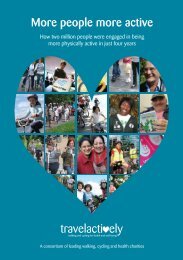Travel in London Travel in London
travel-in-london-report-8
travel-in-london-report-8
Create successful ePaper yourself
Turn your PDF publications into a flip-book with our unique Google optimized e-Paper software.
11. Spotlight: How has travel by <strong>London</strong>ers changed – <strong>in</strong>sights from 10 years of the <strong>London</strong> <strong>Travel</strong><br />
Demand Survey (LTDS)<br />
Recent trends for walk<strong>in</strong>g <strong>in</strong> <strong>London</strong><br />
Walk<strong>in</strong>g is the most common way to get around <strong>in</strong> <strong>London</strong>, and the number of walk<br />
trips and stages are expected to grow <strong>in</strong> l<strong>in</strong>e with population growth and <strong>in</strong>creased<br />
public transport usage. Table 11.6 shows how key <strong>in</strong>dicators of walk<strong>in</strong>g have<br />
evolved over the period covered by LTDS.<br />
Table 11.6<br />
Trends <strong>in</strong> walk<strong>in</strong>g <strong>in</strong> <strong>London</strong>. All people.<br />
Year<br />
Number of<br />
walk trips<br />
(millions)<br />
Number of<br />
trips<br />
(millions)<br />
Walk mode share (%)<br />
Growth <strong>in</strong> walk<br />
trips (% change<br />
from previous<br />
year)<br />
Growth <strong>in</strong> all trips<br />
(% change from<br />
previous year)<br />
2006 5.7 23.8 24.1% 1.0% 1.8%<br />
2007 5.8 24.3 23.8% 1.3% 2.3%<br />
2008 5.9 24.6 23.9% 1.5% 1.2%<br />
2009 6 24.8 24.1% 1.7% 0.9%<br />
2010 6.1 25.1 24.2% 1.5% 1.2%<br />
2011 6.2 25.3 24.4% 1.8% 0.9%<br />
2012 6.3 25.8 24.3% 1.3% 1.7%<br />
2013 6.3 26.1 24.3% 1.3% 1.2%<br />
Source: TfL Plann<strong>in</strong>g, Strategic Analysis.<br />
Future projections of walk<strong>in</strong>g <strong>in</strong> <strong>London</strong><br />
Figure 11.32 shows expected future trends for walk<strong>in</strong>g <strong>in</strong> <strong>London</strong>. Focus<strong>in</strong>g on the<br />
total <strong>London</strong> figures (not just <strong>London</strong> residents), the number of daily walk trips is<br />
expected to <strong>in</strong>crease from 6.2 million <strong>in</strong> 2011 to 8.0 million <strong>in</strong> 2041 (an <strong>in</strong>crease of<br />
29 per cent), largely reflect<strong>in</strong>g population growth.<br />
Figure 11.32<br />
Forecast long-term trajectory for walk<strong>in</strong>g <strong>in</strong> <strong>London</strong>.<br />
50<br />
36 million walk<br />
journeys<br />
41 million walk<br />
journeys<br />
44 million walk<br />
journeys<br />
47 million walk<br />
journeys<br />
45<br />
+ 2.4 million stages<br />
+ 2.5 million stages<br />
+ 0.4 million trips<br />
Number of walk journeys (millions)<br />
40<br />
35<br />
30<br />
25<br />
20<br />
15<br />
29.8 million walk stages<br />
walked dur<strong>in</strong>g trips by other<br />
ma<strong>in</strong> modes<br />
+ 4.1 million stages<br />
+ 0.8 million trips<br />
+14%<br />
from<br />
2011<br />
+ 0.6 million trips<br />
+22%<br />
from<br />
2011<br />
+30%<br />
from<br />
2011<br />
10<br />
-<br />
5<br />
6.2 million walk-all-the-way<br />
trips<br />
2011 2021 2031 2041<br />
Source: TfL Plann<strong>in</strong>g, Strategic Analysis.<br />
240 <strong>Travel</strong> <strong>in</strong> <strong>London</strong>, Report 8








